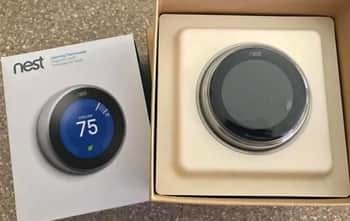Are Nest Thermostats Accurate with Humidity(Plus Calibration Tips)
When you buy through our links, we may earn an affiliate commission.
The Nest Thermostat is a revolutionary system that automatically adjusts your home’s temperature to the perfect level. It also has a humidity sensor that can detect when you need to use the humidifier or dehumidifier. But how accurate are these sensors?
Room thermostats like Nest thermostats are generally less accurate than lab-grade instruments but they have excellent performance in measuring conditions around them, like humidity often in the +/- 1% range. However, this accuracy can be affected by certain factors.
Nest thermostats offer accurate humidity readings, but it’s crucial to calibrate them for the best results. This blog post will explore how to calibrate your thermostat for the best performance and discuss some of the factors that may affect its accuracy. So, let’s get this show on the road. Shall we?
Nest Thermostat Humidity Accuracy
Humidity is an important factor to consider when it comes to home comfort. On average, most people are comfortable at a humidity level of about 40%. This percentage can vary depending on the time of year and where you live.
However, if your humidifier or air conditioner isn’t working properly, this number will rise either too high or too low. The Nest Thermostat is touted to help with this problem, but how accurate is it?
The Nest thermostat is quite accurate, often in the +/- 1% range. However, you may notice different humidity readings between the Nest Thermostat and a portable dehumidifier. Why is this?
While the Nest thermostat is quite reliable and provides accurate humidity readings, its behaviour and readings can be significantly affected by external factors such as:
Thermostat Mounting Location
One of the biggest factors that will affect the Nest Thermostat’s humidity readings is its location. The device must be mounted at least 52 to 60 inches above floor level for it to measure your home’s relative humidity levels accurately. This also means you should avoid installing the thermostat near vents or other heat sources, as this could interfere with its measurements.
Make sure the thermostat is mounted somewhere where it has good visibility of the room so that it can capture all readings in your home.
Exposure to Air Currents and Sunlight
Another reason why Nest Thermostats are not accurate with humidity is because of exposure to direct sunlight. It has been observed that the device tends to give lower readings when positioned near windows, doors or air vents. To make sure you get an accurate reading, it’s best to place your thermostat away from any sort of outdoor exposure.
Exposure to Air Flow from an Air Duct
You should also ensure that your thermostat is not positioned near an air duct. Even a small airstream can significantly impact the humidity readings, so it’s best to keep this in mind if you want an accurate reading from Nest Thermostats.
Heat Gain and Heat Loss From the Wall
The wall where you’ve placed your thermostat should be a good insulator. If the wall is not insulated, it will cause heat loss and gain, which can skew humidity readings for Nest Thermostats. Also, make sure that you’re placing your device in an area with no direct access to sunlight or artificial lights because this may also affect your Nest thermostat’s reading accuracy.
Nest Thermostat Calibration Tips
Nest has created a thermostat that adjusts itself based on the temperature in your home, meaning it also accounts for humidity levels! For the device to work correctly, though, you need to calibrate it to know how much moisture is in your air. Here’s how to go about it:
Restart the Thermostat
The easiest way to recalibrate your Nest Thermostat is to simply restart the device. To do this, simply press the Nest display button until the screen turns black, then turn it on again. Doing so will reset the device, and it should be able to give accurate readings not only for humidity but also temperature.
Factory Reset
If restarting the thermostat doesn’t do the trick, consider factory resetting the device. To do so:
- Check the voltage.
- Restart the Nest in the settings. Go to reset and restart.
- Go to the factory reset or default.
- Follow the setup process in Step 3.
A factory reset allows you to set the device to its original settings. Therefore, if any error occurred while in use that affected the readings, it should be resolved after resetting it, and you should have more accurate readings.
Wrapping Up
If you are wondering about Nest thermostats’ accuracy with humidity, you’re probably getting different readings than what you expect. These thermostats tend to be extremely accurate but can be affected by environmental factors and positioning. Therefore, make sure nothing is interfering with the device’s accuracy or consider calibrating it for more accurate results. Doing so should fix the inaccuracy problems you’re facing.

